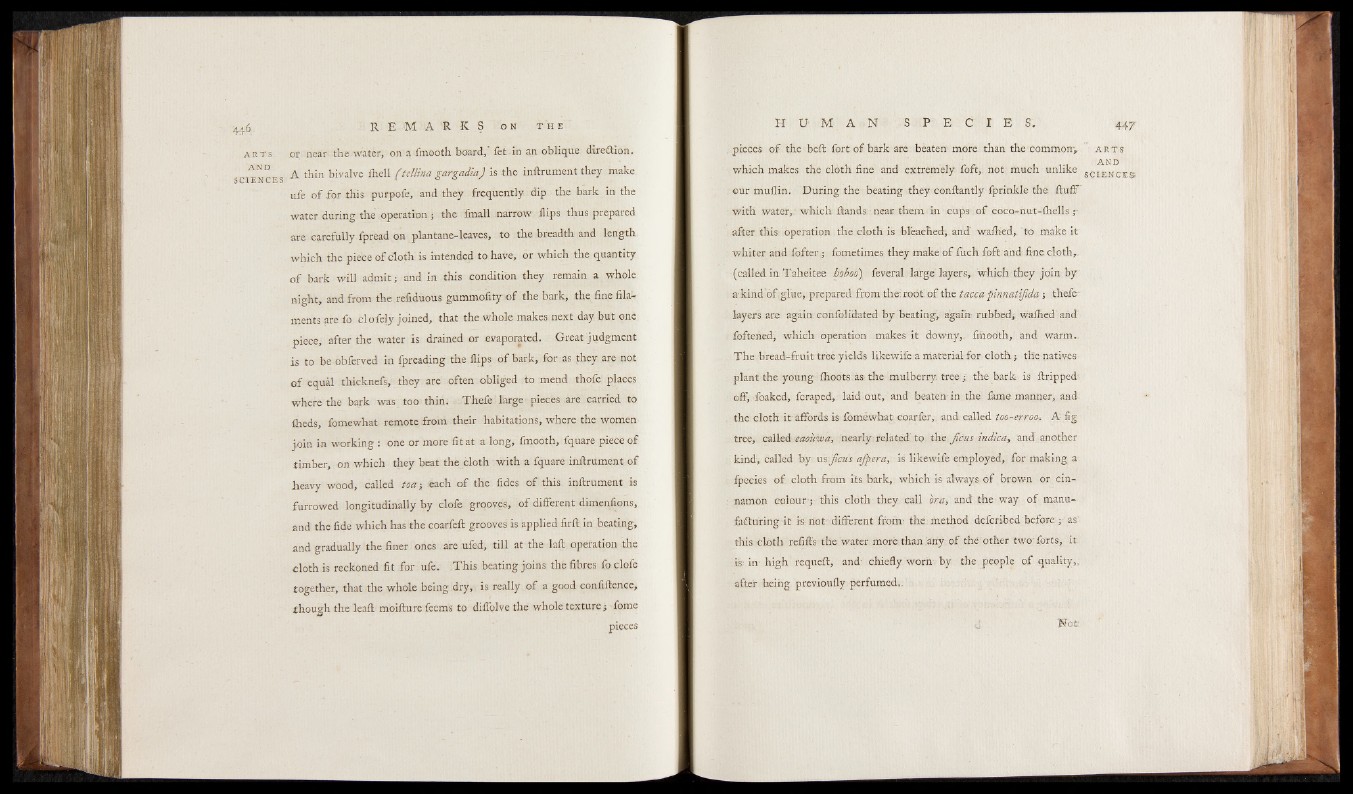
ARTS.
AMD
SCIENCES
or near the water, on a frnooth board, let in an oblique direction.
A thin bivalve fhell ftellina gargadia) is the inftrument they make
ufe of for this purpofe, and they frequently dip the bark in the
water during the operation ; the fmall narrow flips thus prepared
are carefully fpread on plantane-leaves, to the breadth and length
which the piece o f cloth is intended to have, or which the quantity
o f bark will admit; and in this condition they remain a whole
night, and from the reliduous gummofity o f the bark, the fine filaments
are fo clofely joined, that the whole makes next day but one
piece, after the water is drained or evaporated. Great judgment
is to be obferved in fpreading the flips o f bark, for as they are not
o f equal thicknefs, they are often obliged to mend thofe places
where the bark was too thin. Thefe large pieces are carried to
fheds, fomewhat remote from their habitations, where the women
jo in in working : one or more lit at a long, frnooth, fquare piece o f
timber, on which they beat the cloth with a fquare inftrument of
heavy wood, called toa-, each o f the fides of this inftrument is
furrowed longitudinally by clofe grooves, o f different dimenlions,
and the fide which has the coarfeft grooves is applied firft in beating,
and gradually the finer ones are ufed, till at the laft operation the
cloth is reckoned fit for ufe. This beating joins the fibres fo clofe
together, that the whole being dry, is really o f a good confidence,
though the leaft moifture feems to diffolve the whole texture; fome
pieces
I]
H U M A N S P E C T E S .
pieces o f the beft fort of bark are beaten more than the common-,
which makes the cloth fine and extremely foft, not. much unlike
our muflin. During the beating they conftantly fprinkle the fluff"
with water,, which: Hands-' near them in cups* o f coco-nut-fticlls ;
after this operation the cloth is bleached, and walhed, to make it
whiter and fofter; fometimes they make o f fuch foftand- fine cloth,
(called in Taheitee hoboo) feveral large layers, which they join by
a.kind o f glue, prepared, from the: root o f the tacca pin n atifid a ; thefe*
layers ar.e again confolidated by beating, again rubbed; walhed and
fbftened, which operation makes it downy,, frnooth, and warm.
Th e bread-fruit'tree yields likewifea material for c loth ; the natives
plant the youn g'fhoots as the mulberry tree;, the bark is ftripped;
off, foaked, fcraped, laid out, and beaten-in the fame manner, and
the cloth it affords is fomewhat coarfer, and called tao-erroo-, A fig
tree, called eaouwa, nearly related to the fic u s indica, and another
kind, called by us:ficu s afpera, is likewife employed, for making a
fpecies o f cloth from its. bark, which is always o f brown or cinnamon
colour ; this cloth they call ora, and the way of manufacturing
it is:. not different from- the method defcribed b e fo r e a s '
this cloth refills the water more than any o f the other two" forts, it
is; in- high requeft, and- chiefly worn, by the people of quality,,
after heing previoufly perfumed.
ARTS
AND
SCIENCES!
N o t